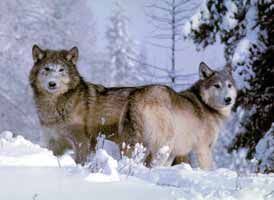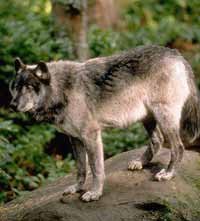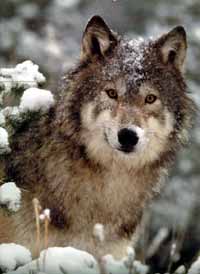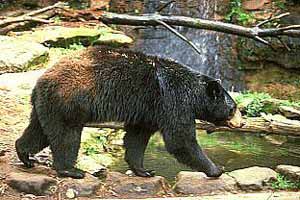| Home | History | Interesting Facts | Contribution | Contact | Links | Photos |


|
|
 |
||
|
Few young animals appear more adorable than wolf pups, especially as they begin exploring their surroundings. But. Even though they look and behave, much like domestic dogs, wolves are highly instinctual and not recommended as pets. In their natural environment, pups leave the den and Mom's close care when they're a month old, but continue to receive "helpful advice" from not only their parents but all members of the pack. Gray, or timber, wolves are one of three species. The red wolf (Canic rufus) is attempting a protected comeback in southeastern United States, while a third species, the Ethiopian wolf (Canis simensis), lives in Africa and Ethiopia. All three are curios, intelligent and highly socialized within their packs, but when confronted by humans, become shy and easily frightened. In fact, despite the many stories painting wolves as dangerous, no documented human deaths have ever been the result of a wolf attack. Day or night, whenever hunger strikes, a pack heads out in search of prey- usually elk, moose, deer, caribou, sheep, musk ox or bison. While in the hunt, the pack may average only five miles an hour but travel 10 to 25 or more miles a day. Now THAT'S persistence! Packs have also been observed causing a stampede of larger animals, working together to bring down a sick or weak straggler. Interestingly enough, if they haven't eaten in several days, wolves may actually gorge themselves with 20 pounds of meat� each!
Howling is a form of communication within and between packs. One pack's howls, for example, warn another against entering its territory, which serves to avoid potential conflict. Also, a lost member's howl helps the pack relocate it more easily. Wolves like to "sing" for fun but will also howl in apparent sadness at the loss of a partner. And although legend has it that these wily vocalists howl at the moon, current studies suggest their harmonies are merely more easily heard in the still of the night. Throughout history, wolves and humans have struggles to get along, especially as both have expanded their searches for land and its resources. Fortunately, the lessons of recent years have shed new light on the wolf, and centuries of frightening folklore have been replaced with factual information about this animal's important role in the balance of nature.
Despite their natural curiosity, wolves fear humans and almost always run from them. Indeed, there are no verified reports of human deaths caused by wolves in North America. Several separate injuries occurring in the late 1990s were caused by a few wolves that had lost their fear of humans. However, statistics prove there is less chance of being injured by a wolf than being struck by lightening. With this perspective, we can respect wolves as we would- and should- any instinctive predator in the wild.
Wolves do not hibernate but remain in search of food sources throughout the cold winter months. A pack's bond is actually greatest this time of year, when a lack of weakened or young prey means a pack must ban together to seek out and bring down larger and stronger animals. Observing this role as a natural part of big-game overpopulation control has helped humans understand the importance of finding ways to coexist with this intelligent and spirited creature. The pads on a wolf's paws are packed with blood vessels. So, as the wolf runs and the circulation in its feet increases, enough heat is produced to keep its feet warn in even the coldest climates, These pads also contain more scent glands than anywhere else on a wolf's body, releasing pheromones that mark territory with every step. Also, a pregnant female uses her paws to dig a den ten or more feet in length, where her pups will be born several weeks later. Polar bears are excellent swimmers. They have been known to swim more than 60 miles without a rest.
|
|||
|
Frequently Asked Questions about Wolves
What are the species of wolves?
1. What are the species of wolves?
(top) There are three species of wolves in the world: the gray wolf (Canis lupus), the red wolf (Canis rufus) and the Ethiopian (or Abyssinian) wolf, (Canis simensis). Some researchers believe the Ethiopian wolf is not a wolf, but actually a jackal. 2. What are the subspecies of the gray wolf? (top) The gray wolf, Canis lupus, lives in the northern latitudes around the world. There are five subspecies of the gray wolf in North America and seven to 12 in Eurasia. The currently recognized subspecies in North America are:
Subspecies are often difficult to distinguish from one another. This is because they interbreed where their ranges overlap so that their populations tend to blend together rather than form distinctive boundaries. The different traits we see in subspecies are likely the result of geographic range, available habitat, and prey base. Skull dimensions, overall size, fur color, and the length of appendages are some of the characteristics that differ between subspecies of gray wolf. 3. What is a pack of wolves? (top) Wolves usually live in packs which consist of the adult parents, referred to as the alpha pair, and their offspring of perhaps the last 2 or 3 years. The adult parents are usually unrelated and other unrelated wolves may sometimes join the pack. 4. How many wolves are in a pack? (top) Pack size is highly variable because of birth of pups, dispersal, and mortality. Generally, a gray wolf pack has from six to eight wolves, but in Alaska and northwestern Canada some packs have over 30 members. Red wolf packs are generally smaller than gray wolf packs and usually have 2 to 8 members, but a pack of 12 is known in the wild. 5. What is a pack territory size? (top) Territory size is highly variable. Gray wolf territories in Minnesota range from about 25 to 150 square miles, while territories in Alaska and Canada can range from about 300 to 1,000 square miles. Red wolf territories can be from 10 to 100 square miles, but the territories of red wolves reintroduced into North Carolina have been 38 to 87 square miles. 6. When do wolves breed? (top) Wolves breed at slightly different times, depending on where they live. For example, gray wolves in the Great Lakes Region breed in February to March, while gray wolves in the Arctic may breed slightly later in March to April. Red wolves usually breed in January or February. 7. What is the gestation period of a wolf? (top) The gestation period of gray and red wolves is usually around 63 days. 8. How many pups are born in a pack each year? (top) A pack normally has only one litter of pups each spring, but in areas of high prey abundance more than one female will give birth in each pack. An average litter size for gray and red wolves is 4 to 6, but several may die if natural prey is not readily available. 9. How much do wolf pups weigh? (top) Gray wolf pups weigh 1 pound at birth, while red wolf pups weigh less than a pound at birth. 10. How much do adult wolves weigh? (top) Adult female gray wolves in northern Minnesota weigh between 50 and 85 pounds, and adult males between 70 and 110 pounds. Gray wolves are larger in the northwestern United States, Canada, and Alaska where adult males weigh 85 to 115 pounds and occasionally reach 130 pounds. Adult female red wolves weigh 40 to 75 pounds, while males weigh from 50 to 85 pounds. 11. How big are wolves? (top) The average length (tip of nose to tip of tail) of an adult female gray wolf is 4.5 to 6 feet; adult males average 5 to 6.5 feet. The average height (at the shoulder) of a gray wolf is 26 to 32 inches. The average length (tip of nose to tip of tail) of an adult red wolf is 4.5 to 5.5 feet. The average height (at the shoulder) of an adult red wolf is about 26 inches. 12. How big is a gray wolf's track? (top) The size of a wolf's track is dependent on the age and size of the wolf, as well as the substrate the track was made in. A good size estimate for a gray wolf's track size is 4 1/2 inches long by 3 1/2 inches wide. In comparison, a coyote's track will be closer to 2 1/2 inches long by 1 1/2 inches wide. Only a few breeds of dogs leave tracks longer than 4 inches (Great Danes, St. Bernards, and some bloodhounds). 13. How many teeth does an adult wolf have? (top) Adult gray and red wolves have 42 teeth, while adult humans have 32. 14. How strong are a gray wolves' jaws? (top) The massive molars and powerful jaws of a wolf are used to crush the bones of its prey. The biting capacity of a wolf is 1,500 pounds of pressure per square inch. The strength of a wolf's jaws makes it possible to bite through a moose femur in six to eight bites. In comparison, a German shepherd has a biting pressure of 750 pounds per square inch. A human has a much lower biting pressure of 300 pounds per square inch. 15. What do wolves eat? (top) Gray wolves prey primarily on large, hoofed mammals such as white-tailed deer, mule deer, moose, elk, caribou, bison, Dall sheep, musk oxen, and mountain goat. Medium sized mammals, such as beaver and snowshoe hare, can be an important secondary food source. Occasional wolves will prey on birds or small mammals. Red wolves primarily prey on white-tailed deer, raccoons, rabbits and rodents. 16. How much do wolves eat? (top) Gray wolves can survive on about 2 1/2 pounds of food per wolf per day, but they require about 5 pounds per wolf per day to reproduce successfully. The most a gray wolf can eat in one sitting is about 22.5 pounds. Red wolves eat an average of 5 pounds of food per day, but have been known to eat up to 12 pounds in one sitting. 17. How many prey do gray wolves kill per year? (top) In Minnesota, wolves kill the average equivalent of 15 to 20 adult-sized deer per wolf per year. Given the 1997-98 estimate of 2,450 wolves in Minnesota, that would equal about 36,750 to 49,000 deer killed by wolves. In comparison, from 1995-1999 hunters killed between 32,300 to 78,200 deer each year in Minnesota's wolf range. In addition, several thousand deer are killed during collisions with vehicles each year. 18. How long do wolves live? (top) Gray wolves in the wild have an average life span of 6 to 8 years, but have been known to live up to 13 years in the wild and 16 years in captivity. Red wolves in the wild have an average life span of 8 to 9 years, but have been known to live up to 12 years in the wild and 16 years in captivity. 19. What do gray wolves die from? (top) The natural causes of wolf mortality are primarily starvation, which kills mostly pups, and death from other wolves because of territory fights. While not usually a big problem, disease such as mange and canine parvovirus can be a concern in small and recovering populations. Injuries caused by prey results in some deaths. Human-caused mortality including legal, illegal, and accidental causes, can be high in some populations. Pup mortality rates are highly variable, but approximately 40 to 60% of wolf pups die each year. 20. How fast can gray wolves run? (top) Wolves will travel for long distances by trotting at about five miles per hour. They can run at speeds of 25 to 35 miles per hour for short bursts while chasing prey. 21. How far can gray wolves travel? (top) Wolves may travel 10 to 30 miles each day in search of food. Dispersing wolves, those leaving packs in search of their own mate, have been known to travel distances of 550 miles away form their home territory. |
|||
© SCCW Inc. All Rights Reserved

